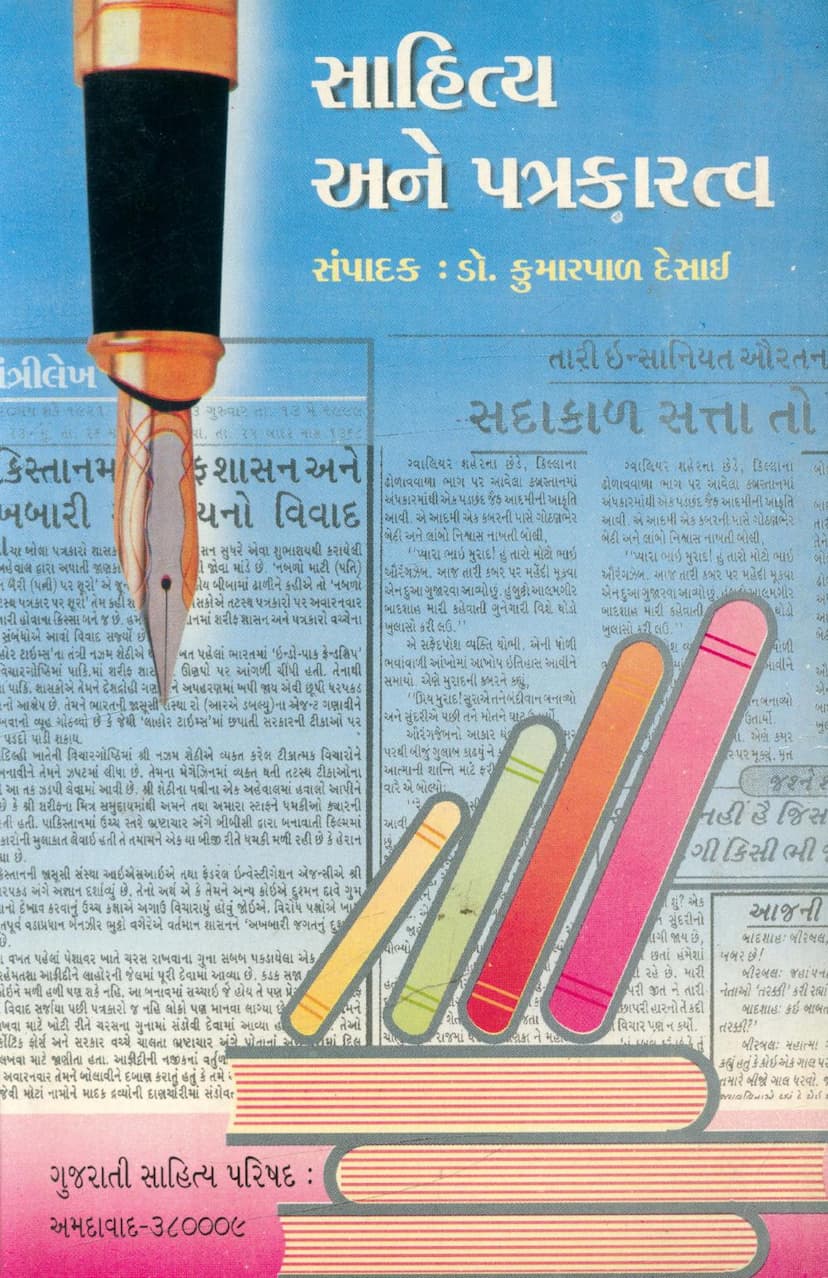Sahitya Ane Patrakaratva
Added to library: September 2, 2025

Summary
Here's a comprehensive summary of the Jain text "Sahitya Ane Patrakaratva" by Kumarpal Desai, based on the provided pages:
Book Title: Sahitya Ane Patrakaratva (Literature and Journalism) Author: Kumarpal Desai Publisher: Gujarati Sahitya Parishad Date of Publication: First edition: 1980, Second (expanded) edition: 1999 Price: 130 Rupees Print Run: 550 copies
Overall Theme:
The book, "Sahitya Ane Patrakaratva," compiles essays and discussions from a seminar organized by the Gujarati Sahitya Parishad on the relationship between literature and journalism. It explores the nuanced interplay, commonalities, and distinctions between these two fields, highlighting their mutual influence, the role of language, and the evolving landscape of journalism. The book emphasizes the importance of ethical practices, intellectual rigor, and creative expression in both domains.
Key Themes and Discussions:
-
The Intertwined Nature of Literature and Journalism:
- Both literature and journalism use language as their raw material but have different objectives. Literature aims for timeless expression and artistic beauty (like the Taj Mahal), while journalism focuses on timely information and immediate impact (like a functional house).
- Many prominent writers were also journalists (e.g., Gandhiji, Munshi, Meghani), and vice-versa, demonstrating the permeable boundaries between the two.
- The core subject for both is human collective life. Journalism acts as a chronicler of society's history, while literature paints a picture of individuals and society through art.
-
The Power and Evolution of Journalism:
- Journalism is portrayed as a powerful force, the "fourth estate," essential for a democratic society. It has the power to inform, shape public opinion, and hold power accountable.
- The history of journalism is marked by its role in fighting injustice and advocating for the common person.
- The evolution of Gujarati journalism is traced from its early days, highlighting the contributions of various pioneering figures and publications like "Mumbai Samachar," "Dandiyo," and Gandhiji's "Navjivan."
- The shift from journalism as a "mission" to a "business" after independence is noted, with increasing influence of money and politics leading to potential compromises in integrity and objectivity.
-
Language and Expression:
- Language is the common ground but used differently. Journalists prioritize brevity, clarity, and directness, often using colloquial language for wider reach. Literature, conversely, explores the aesthetic, sonic, and lyrical qualities of language, treating it as both a tool and an end in itself.
- The book discusses the importance of developing Gujarati language through new vocabulary and stylistic innovations, acknowledging the influence of English and the need for better translation practices.
-
The Journalist's Role and Challenges:
- Active vs. Passive Journalism: The book critiques the passive role of many modern journalists who have become mere conduits for owners' or political agendas, losing their original truth-seeking mission.
- Ethical Considerations: The importance of truthfulness, accuracy, impartiality, and avoiding sensationalism is stressed. The potential for media manipulation through advertising and political influence is highlighted.
- Professional Development: The need for proper training, specialization, improved working conditions, fair wages, and access to reference materials for journalists is emphasized.
- The Dilemma of Ownership: The tension between the commercial interests of newspaper owners and the ethical responsibility of journalism is a recurring theme. The idea of "trusteeship" in newspaper ownership is proposed as a solution.
- The Journalist's Persona: The ideal journalist is depicted as someone with courage, integrity, impartiality, a broad worldview, intellectual depth, and a commitment to public service. The challenges in maintaining this ideal in the face of commercial pressures and political interference are acknowledged.
-
Literary Journalism and Other Forms:
- The seminar explored various aspects of journalistic writing, including editorial columns ("tanteen lekho"), satire poetry ("kataksh-kavita"), reporting, and the influence of journalism on literary style.
- The importance of literary magazines ("sahityik samayiko") as platforms for creative expression, intellectual discourse, and shaping literary trends is discussed, with examples of influential Gujarati magazines.
- The book acknowledges the debate on whether certain journalistic pieces qualify as literature, referencing Bernard Shaw's idea that "All Literature is Journalism."
-
The Impact on Society and Culture:
- Journalism plays a crucial role in shaping public opinion, disseminating information, and fostering social change.
- However, the book also raises concerns about the declining quality of journalistic content, the rise of sensationalism, and the potential neglect of cultural and literary matters in favor of politics and commercial interests.
- The need for newspapers and magazines to contribute to the cultural enrichment of society and develop a discerning readership is emphasized.
-
Specific Issues Discussed:
- Press Freedom: The fundamental right to press freedom is discussed, along with the responsibilities that accompany it.
- Economic Viability: The financial challenges faced by newspapers, especially smaller ones, are explored, including the impact of rising costs (newsprint, technology) and the dependence on advertising revenue.
- Media Ethics: The seminar touched upon the importance of an ethical code for journalists, covering aspects like truthfulness, impartiality, and the distinction between news reporting and opinion pieces.
Key Figures Mentioned:
The book references numerous influential figures in Gujarati literature and journalism, including:
- Mahatma Gandhi
- K.M. Munshi
- Zaverchand Meghani
- Mahadev Desai
- Kakasaheb Kalelkar
- Anandshankar Dhruv
- Narmad
- Karsandas Mulji
- Indulal Yajnik
- Ravi Shankar Raval
- Babulal Rawat
- Chimanlal Patel
- Harindradave
- Suresh Joshi
- Kumarpal Desai (the editor)
- Vadilal Dagli (who delivered the inaugural address)
Concluding Thoughts:
The book concludes by reiterating the vital connection between literature and journalism, emphasizing that while their immediate goals might differ, their reliance on language and their collective impact on society make them inseparable. The seminar aimed to foster dialogue and understanding between writers and journalists to address the challenges and opportunities in their respective fields, ultimately working towards a more informed and culturally enriched society. The expanded edition reflects an effort to update the discussions with changes in the media landscape since the first edition.
This summary provides a comprehensive overview of the main themes, discussions, and figures presented in the book "Sahitya Ane Patrakaratva."